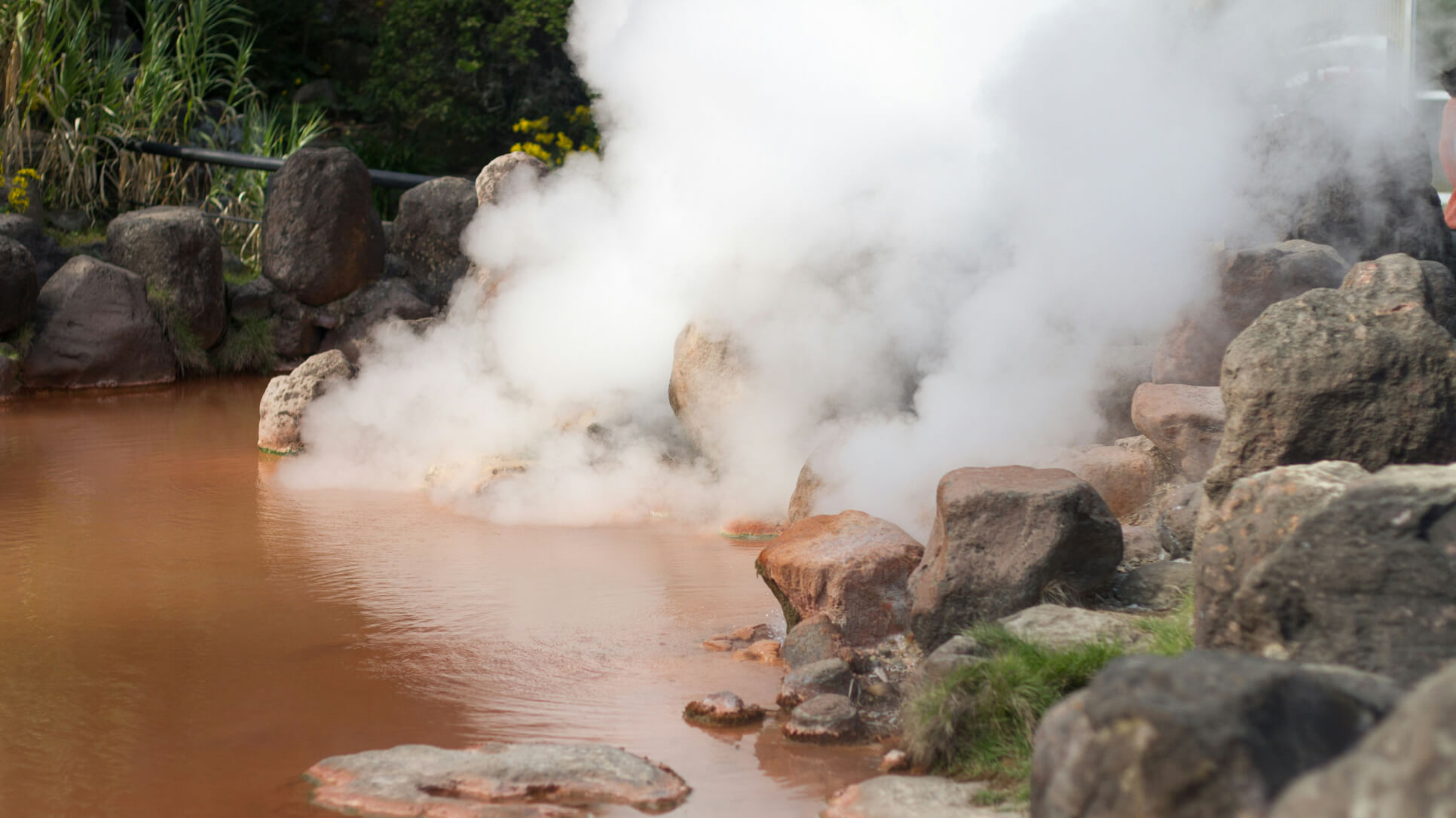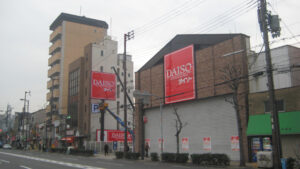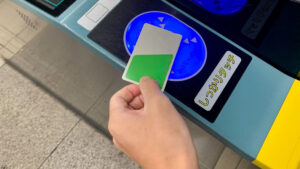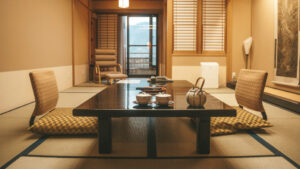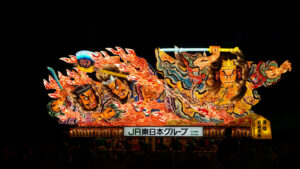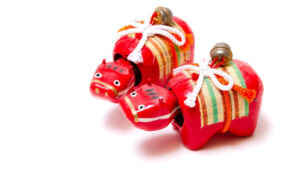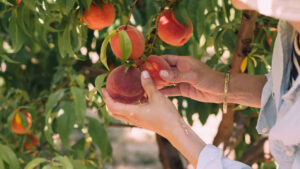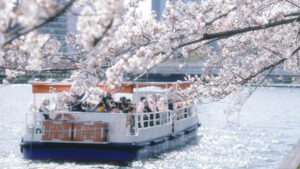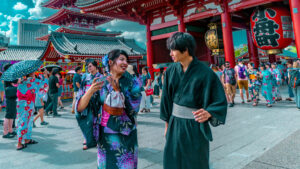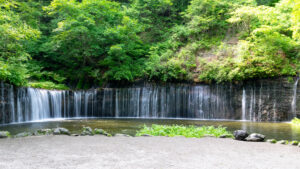Beppu in Oita Prefecture is known as one of the world’s premier hot spring destinations, attracting countless international travelers every year. The sight of steam plumes rising throughout the city is breathtaking—so much so that Beppu is often called a “theme park of hot springs.” Among its most famous attractions is the Beppu Jigoku Meguri (“Hell Tour”), where you can experience the raw power of nature up close.
In this article, we present a clear, traveler-friendly guide to everything you need to know—from Beppu’s fascinating history and onsen culture to how to enjoy the Jigoku Meguri, plus local cuisine and nearby sightseeing.
Contents
The Charm of Beppu: Japan’s Hot Spring City
The History of Beppu, One of Japan’s Leading Hot Spring Areas
Onsen Culture Loved Since the Edo Period
Beppu’s hot springs have been cherished since the Edo period. At that time, they were used as “toji-ba,” or therapeutic hot spring resorts, where people visited not only for bathing but also for extended stays to restore their health. From commoners to samurai, people gathered here to heal both body and mind. This culture of using hot springs for long-term recuperation is still preserved in some traditional inns today.
Development as a Tourist Destination in the Meiji Era
In the Meiji era, the opening of railway lines greatly increased the number of visitors to Beppu. The improvement of Beppu Port made access easier from outside Kyushu, and the city rapidly developed into a hot spring tourist destination. Hotels, inns, and restaurants were built one after another, forming the foundation of the hot spring townscape seen today. At the same time, Japan’s international tourism policies encouraged foreign visitors to come, further enhancing Beppu’s reputation.
Modern Beppu and Its International Popularity
Today, Beppu is a world-famous hot spring resort, attracting travelers from both Japan and abroad. With more than 2,000 hot spring sources and one of the highest output volumes in the world, Beppu boasts an unparalleled scale. The sight of steam rising throughout the city has become a symbol of Japanese onsen culture, often featured in travel magazines and on social media. Unique experiences such as the “Jigoku Meguri” (Hell Tour) and “jigoku-mushi” cuisine also add to its appeal, making Beppu a must-visit destination for international travelers.
Types and Characteristics of Beppu’s Hot Springs
A Wide Variety of Spring Qualities (Carbonated Springs, Sulfur Springs, etc.)
One of Beppu’s greatest attractions is the incredible variety of its hot spring waters. Of the 10 basic spring types found in Japan, Beppu offers 7 of them. Carbonated springs are believed to promote blood circulation, while sulfur springs are loved for their distinctive aroma and skin-beautifying effects. Visitors can also find reddish-brown iron-rich baths and milky-white sulfate springs, allowing them to enjoy different colors, properties, and health benefits each time they visit.
The Beauty of the “Yukemuri” Steam Scenery
What often surprises first-time visitors is the sight of “yukemuri”—white steam rising everywhere across the city. Billowing up from rooftops and mountain slopes, this scenery has become a quintessential image of Beppu and is often described as a “traditional Japanese landscape.” In the Kannawa district especially, the steam is illuminated at night, creating a dreamlike atmosphere that has become a favorite photo spot for tourists.
An Unusually Large Number of Hot Springs Worldwide
Beppu boasts more than 2,000 hot spring sources within the city, ranking among the top in the world. Its daily discharge volume is estimated at about 100,000 kiloliters, making it one of the largest hot spring cities anywhere. Having so many different hot springs concentrated in one area is extremely rare, earning Beppu the nickname “the theme park of hot springs.” For travelers, this means the opportunity to experience multiple spring types and scenic views in a single trip—something that few other destinations can offer.
Access and Basic Travel Information
Access from Fukuoka and Oita
Beppu is located in Oita Prefecture, in the northeastern part of Kyushu, and is relatively easy to reach. From Fukuoka, the JR Limited Express “Sonic” takes about two hours, while buses from Oita Airport reach Beppu in roughly one hour. Highway buses also run frequently from Hakata and Kokura, offering an affordable and popular option. For those coming from farther away, ferries connect Osaka and Kobe with Beppu, allowing travelers to enjoy a leisurely sea journey.
Convenient Transportation for International Travelers
For overseas visitors, the “JR Kyushu Rail Pass” and various bus sightseeing passes provide convenient ways to explore. With these, travelers can not only visit Beppu but also nearby hot spring towns such as Yufuin and other attractions in Oita. Within the city, a well-developed bus network makes it easy to reach highlights like the Jigoku Meguri. English signage and the use of IC transportation cards are also widely available, ensuring smooth travel for foreign tourists.
Combining Beppu with Nearby Sightseeing
Visitors to Beppu can enrich their trip by combining it with nearby sightseeing. A popular choice is Yufuin, a charming hot spring town surrounded by countryside views, stylish cafés, and art museums. A short trip away is Takasakiyama Monkey Park, where wild monkeys can be observed, and the Oita Marine Palace Aquarium “Umitamago,” where travelers can enjoy marine life. For those with more time, exploring Kunisaki Peninsula or Oita City’s historic castle town offers opportunities to experience not only hot springs but also local culture and nature.
What is the Beppu Jigoku Meguri (Hell Tour)?
The Origins and History of the Jigoku Meguri
Why It’s Called “Hell”
In Beppu, the term “jigoku” (hell) refers to natural phenomena where scalding steam, boiling water, and mud erupt from underground. These dramatic scenes appeared terrifying to people in the past, resembling images of hell, and thus came to be called “jigoku.” In fact, some spots reach temperatures close to 100°C, making bathing impossible—visitors can only observe. This unusual natural spectacle has become a unique attraction, offering a “hot spring to see, not to bathe in,” unlike ordinary onsen.
Ancient Beliefs and Legends
The striking landscapes of the jigoku have long been objects of awe and worship. The billowing steam and vividly colored pools, ranging from red to blue, were considered mysterious, and local people performed rituals to pacify the “hells.” Some, such as the Chinoike Jigoku (Blood Pond Hell), were even believed to have healing powers and were used as medicinal baths. These ancient beliefs and legends add cultural depth to the jigoku, enhancing their value as modern tourist attractions.
Development as a Tourist Attraction
From the Meiji to the Showa era, the jigoku sites began to be developed as tourist destinations. Walking paths and viewing facilities were built, allowing visitors to safely enjoy the spectacular scenery. Today, seven of the most famous jigoku are introduced collectively as the “Beppu Jigoku Meguri.” With a convenient all-in-one admission ticket, travelers can tour the sites efficiently. Thanks to these efforts, once-feared natural phenomena have been transformed into thrilling attractions that draw visitors from around the world.
How to Enjoy the Jigoku Meguri
Admission Fees and the All-in-One Pass
The Beppu Jigoku Meguri features seven famous “hells.” Each can be visited individually, but for those wanting to see them all efficiently, purchasing the all-in-one admission pass is highly recommended. As of 2025, the pass costs around 2,400 yen for adults and grants entry to all seven sites. Ticket counters provide information in English and Chinese, making it easy for international visitors to use. Thanks to its convenience and value, most tourists opt for this pass.
Suggested Route and Model Course
There is no fixed order for visiting the jigoku, but the most efficient route usually begins in the Kannawa district, where several sites such as Umi Jigoku (Sea Hell) and Oniishibozu Jigoku (Shaven Head Hell) are clustered. After exploring these, travelers often head to the slightly more distant Chinoike Jigoku (Blood Pond Hell) and Tatsumaki Jigoku (Tornado Hell). While most sites are accessible on foot or by short bus rides, the latter two are farther away, so a car or local bus is recommended for convenience.
Estimated Time Required
Visiting all of the jigoku typically takes about 2 to 3 hours. Since each site offers not only unique scenery but also experiences such as foot baths and souvenir shopping, allocating around half a day ensures a more relaxed and enjoyable visit. For those with limited time, focusing on the three most popular sites—Umi Jigoku, Chinoike Jigoku, and Oniishibozu Jigoku—makes for a satisfying shorter course. One of the highlights of the Jigoku Meguri is the flexibility to tailor the experience to fit any travel schedule.
Highlights for International Travelers
Photogenic Spots
The Beppu Jigoku are truly photogenic destinations. The vivid cobalt blue of Umi Jigoku (Sea Hell), the deep crimson waters of Chinoike Jigoku (Blood Pond Hell), and the bubbling gray mud of Oniishibozu Jigoku (Shaven Head Hell) all showcase striking natural colors and dramatic landscapes perfect for social media. On sunny days, the brilliant blue of Umi Jigoku is especially breathtaking, making it a favorite photo spot among international visitors.
English Signage and Guided Tours
Across the Jigoku Meguri sites, English-language signs are provided, ensuring that basic explanations are easy to understand. Many facilities also distribute brochures in English, Chinese, and Korean, offering reassurance to first-time international visitors. For group travelers, guided tours are available, providing deeper insights into the history and cultural background of the sites. At the same time, the facilities are designed so that individual travelers can also enjoy the experience comfortably and independently.
Seasonal Attractions
The Jigoku Meguri can be enjoyed year-round, with each season offering unique scenery. In spring, cherry blossoms and fresh greenery contrast beautifully with rising steam. In summer, the brilliant blue of Umi Jigoku stands out vividly. Autumn brings colorful foliage combined with atmospheric steam, creating a dreamlike view, while in winter, the cold air makes the billowing steam appear even more dramatic. Each visit offers a new perspective, making the jigoku a destination worth returning to again and again.
Introduction to Beppu’s Seven Hells
Umi Jigoku (Sea Hell)
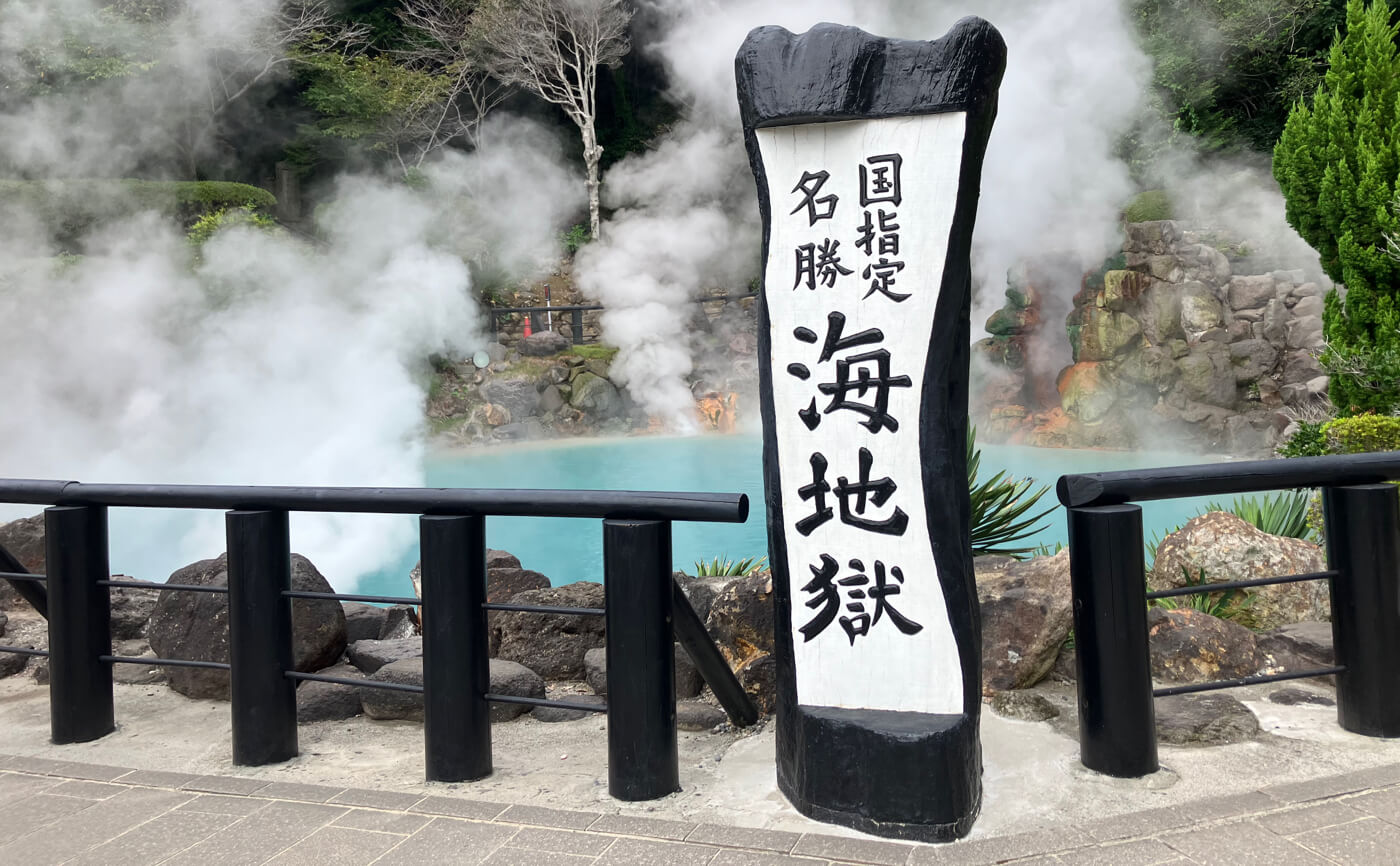
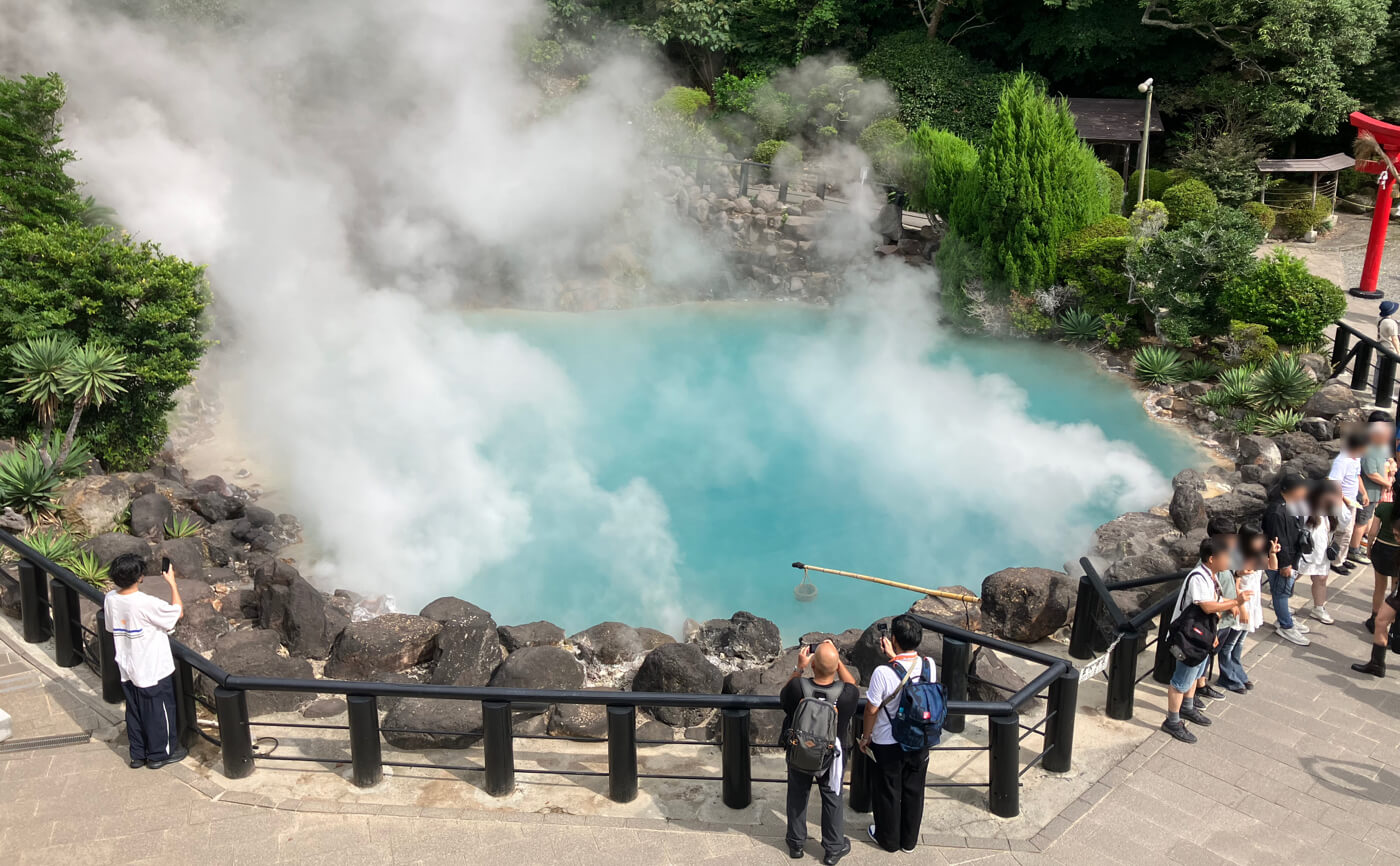
The largest of Beppu’s hells, Umi Jigoku, is filled with striking cobalt blue hot spring water. Its vivid color comes from dissolved iron sulfate, creating a landscape so beautiful that the name “hell” almost feels inappropriate. With water temperatures reaching around 98°C, bathing is impossible, but the site remains one of Beppu’s most captivating attractions.
Within the grounds, the heat of the hot springs is used to cultivate giant Amazonian water lilies and tropical water lilies, which bloom between May and November—especially beautiful in the morning. Visitors can also enjoy a free foot bath, perfect for resting tired legs. Towels are available at the on-site “Shop Hasu,” which also sells regional souvenirs such as onsen eggs and the popular bath powder “Enman no Yu” made from hot spring minerals. A long-time specialty, “Gokuraku Manju” steamed with natural geothermal heat since 1954, delights visitors with its fluffy texture and gentle sweetness.
For a sweet break, the “Cafeteria Umi” serves the famous “Jigoku Steamed Pudding,” making Umi Jigoku a place where visitors can enjoy powerful hot spring scenery, local food, and shopping all in one stop.
Chinoike Jigoku (Blood Pond Hell)
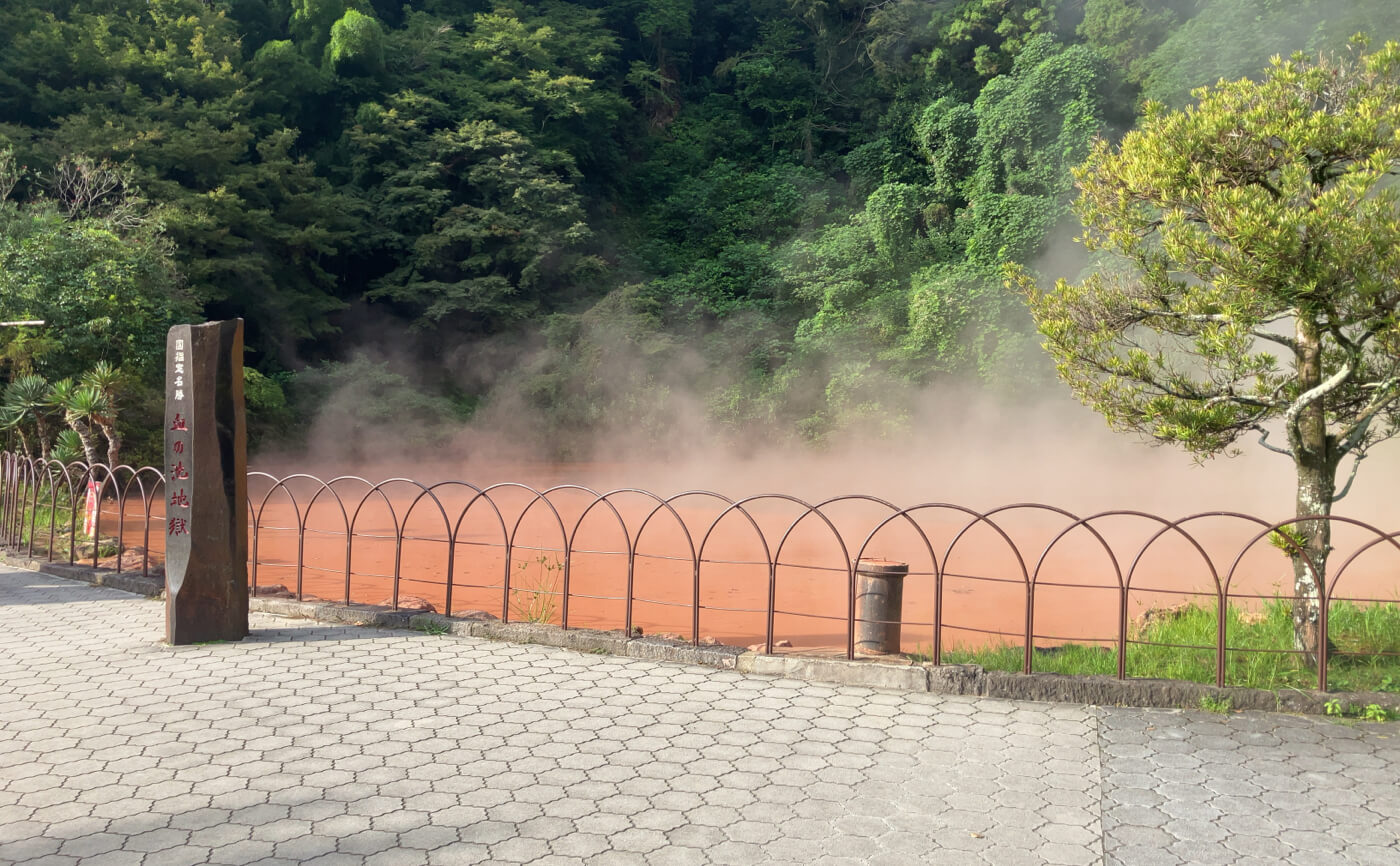
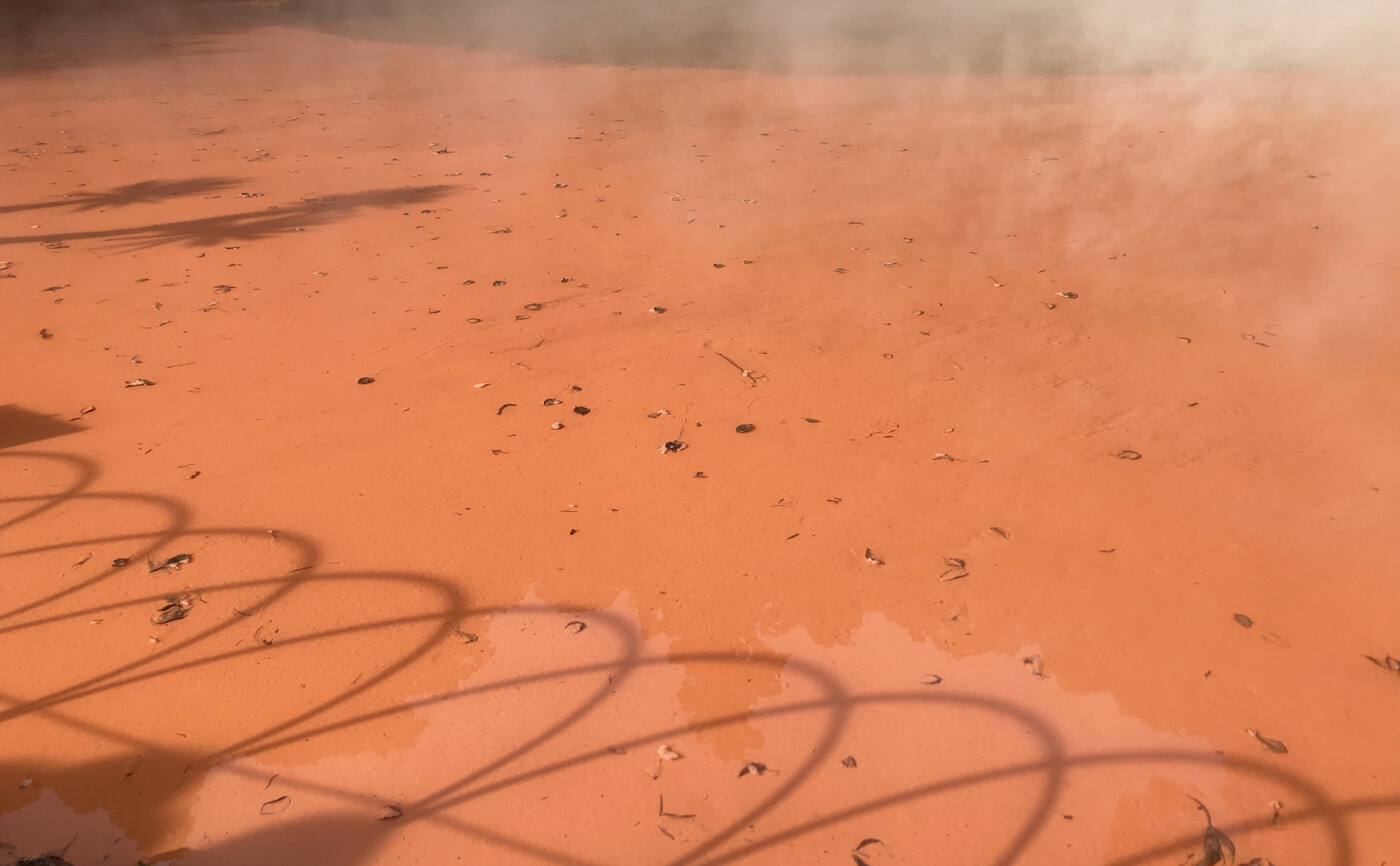
Chinoike Jigoku is known as the oldest hell in Japan, with records dating back over 1,300 years in the Nara-period chronicle Bungo no Kuni Fudoki, where it was referred to as “Akayu-no-Izumi” (Red Hot Spring). The pond’s vivid crimson color comes from red hot mud containing iron oxide and magnesium oxide erupting and accumulating in the basin. The sight of this “red hot mud pond” leaves a lasting impression on all who see it.
The spring quality is an acidic ferruginous spring, covering about 1,300 square meters with a depth of up to 30 meters. The water temperature is about 78°C, with an impressive daily outflow of 1,800 kiloliters.
Visitors can relax at the free foot bath, often enjoyed with the local specialty “Chinoike Pudding.” The spacious 100-tsubo (approx. 330 m²) shop offers local Oita and Beppu souvenirs as well as unique original goods. At the on-site restaurant “Gokurakutei,” travelers can savor Oita’s specialties such as toriten (chicken tempura) and jigoku-steamed set meals.
With its deep historical background, powerful scenery, and combination of food and shopping, Chinoike Jigoku is especially recommended for first-time international visitors to Beppu.
Tatsumaki Jigoku (Geyser Hell)
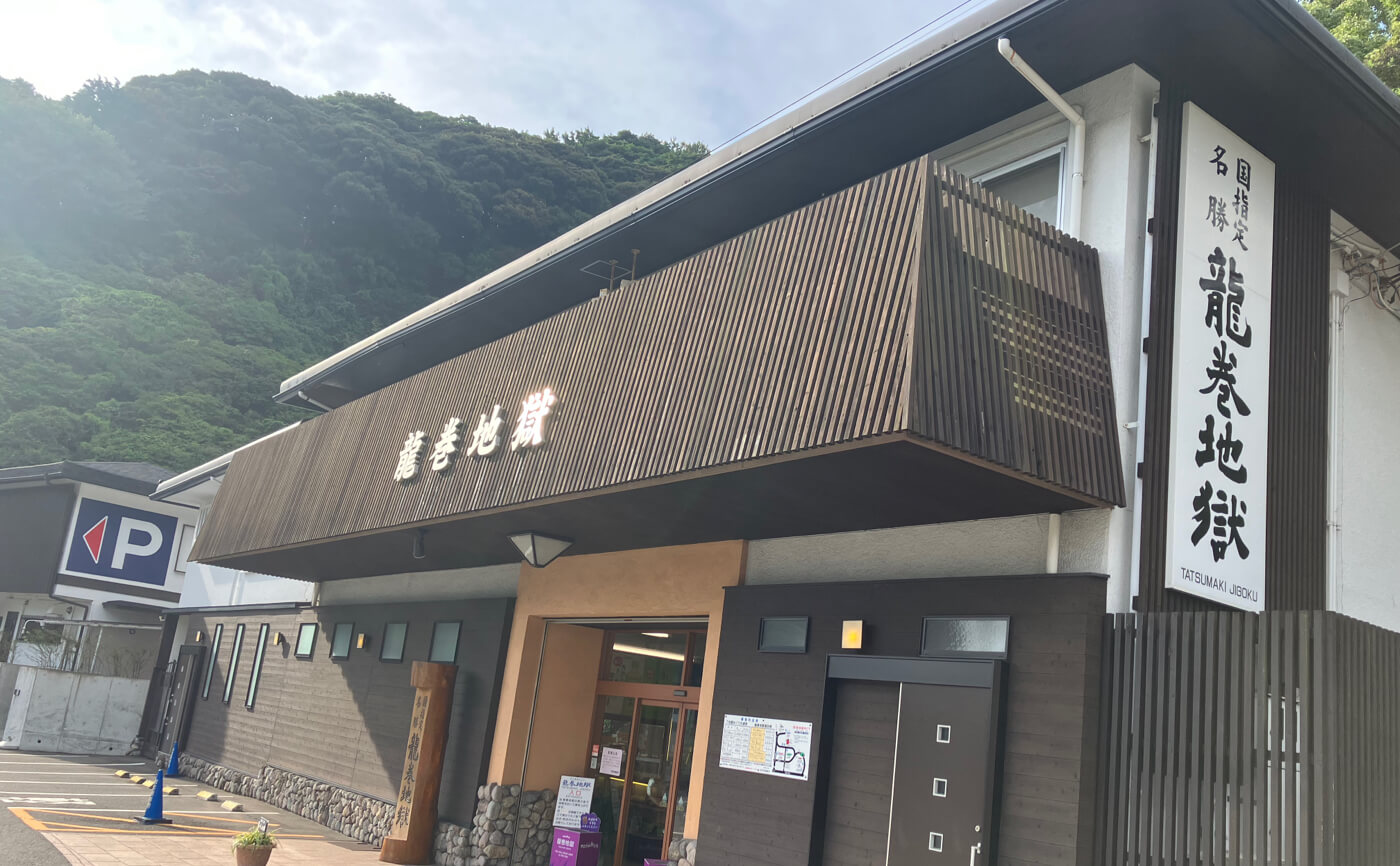
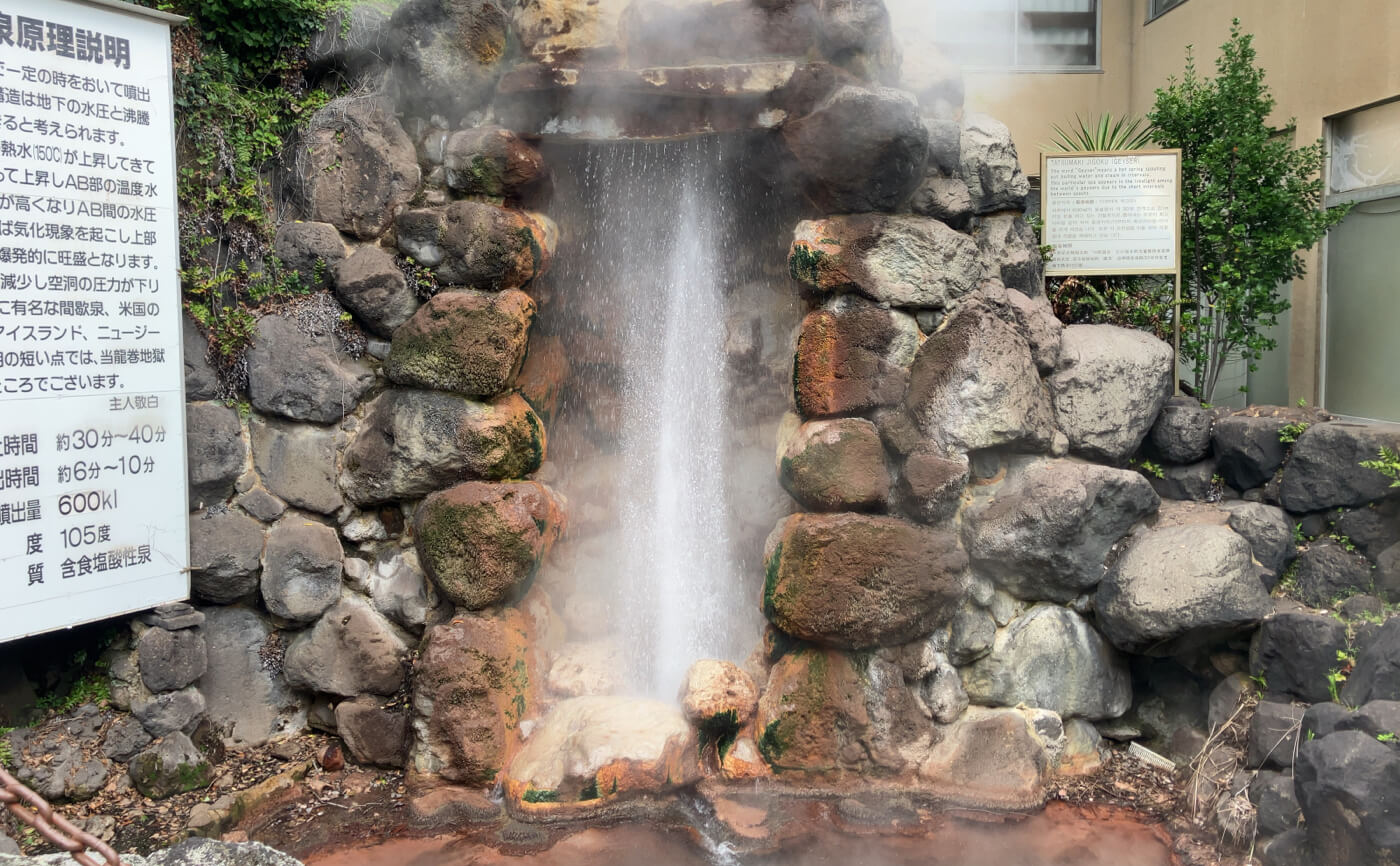
Designated a natural monument of Beppu City, Tatsumaki Jigoku is an active geyser that erupts at regular intervals, shooting boiling water powerfully into the air. Although a roof structure controls the spout for safety, the geyser has the force to reach approximately 30 meters in height. Steam temperatures reach about 105°C, and underground thermal water is around 150°C—an awe-inspiring place to feel nature’s energy up close.
Above the entrance is a signal lamp: when it glows red, an eruption is imminent or underway, making it easy for visitors to time their visit and catch the spectacle.
The shop offers local specialties from Oita and the Kunisaki area, including seasonal mandarins from Tatsumaki Orchard. An adjacent gelato stand serves fresh-squeezed mandarin juice made from the orchard’s fruit and rich gelato crafted with Oita milk—perfect after experiencing the heat of the springs.
Shiraike Jigoku (White Pond Hell)
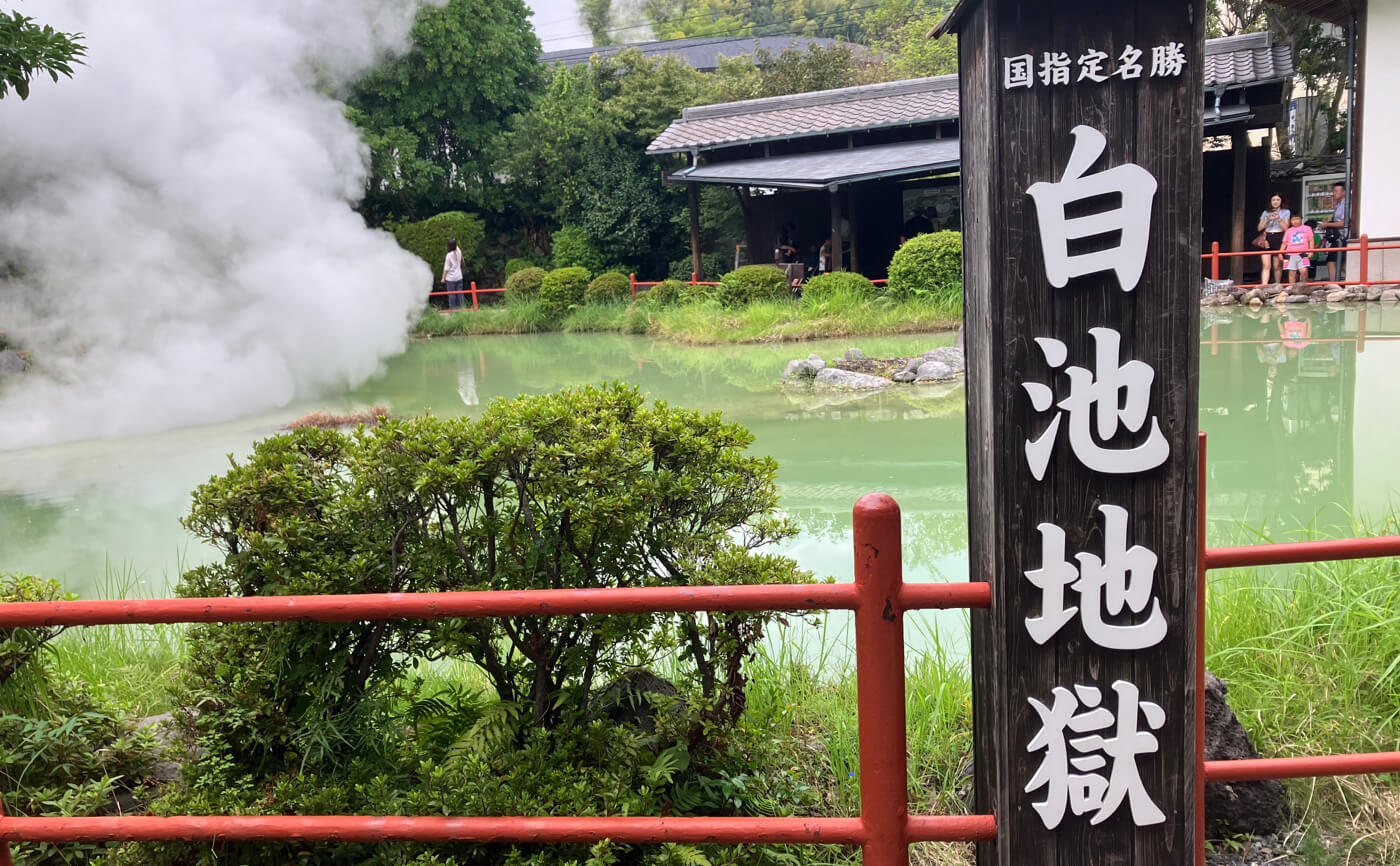
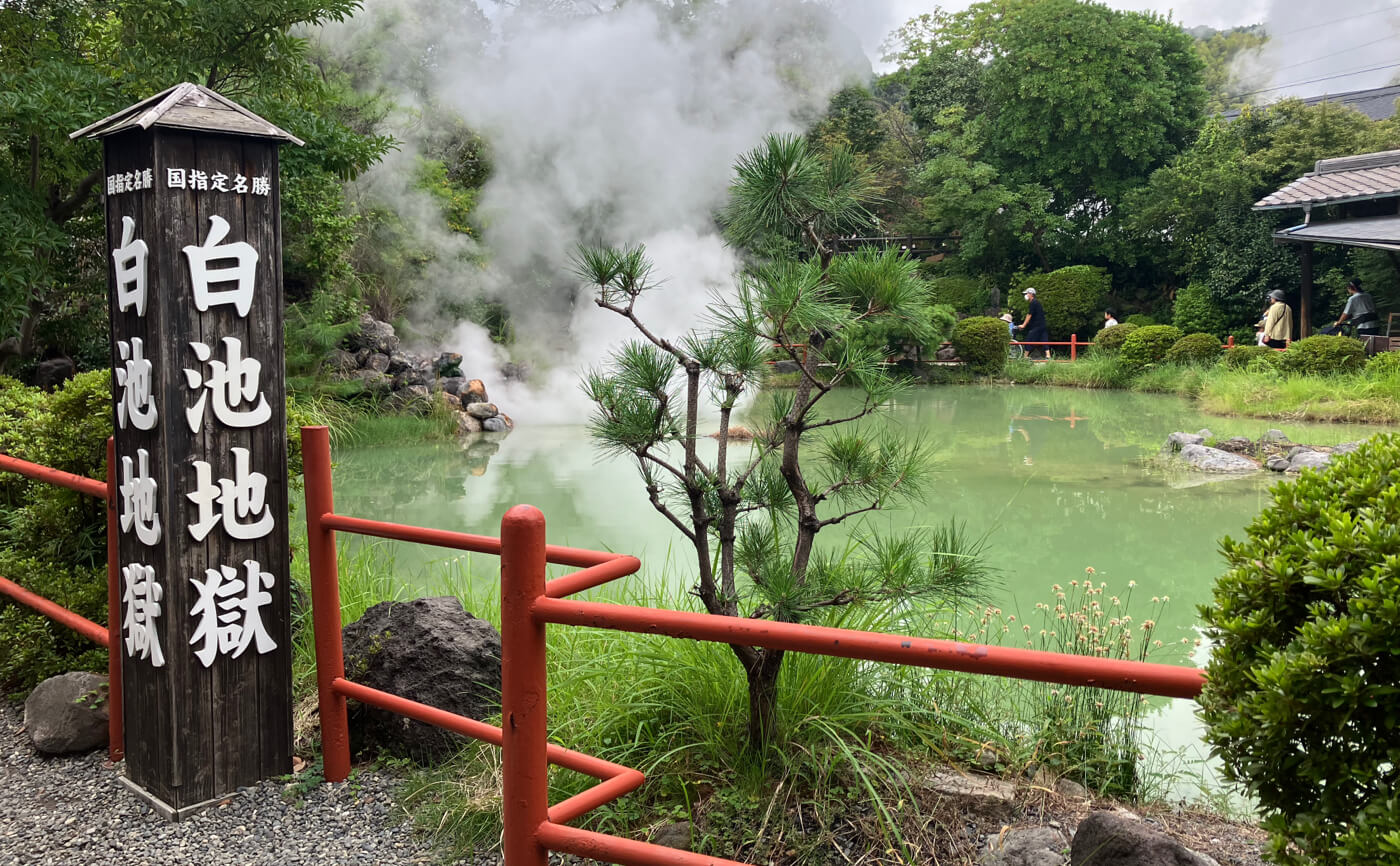
Nestled within a serene Japanese garden, Shiraike Jigoku features hot spring water that emerges colorless and turns pale bluish-white as it cools and depressurizes in the pond. This natural transformation gives the “White Pond” its name. The spring temperature is about 95°C, and the water is a saline type containing boric acid and sodium chloride.
There is plenty to see on the grounds. The Tropical Fish House exhibits around 20 species, including arapaima (pirarucu), piranhas, and arowana—the massive arapaima can grow up to four meters and is especially impressive. Cultural highlights include the prefecturally designated Important Cultural Property Mukaihara Stone Stupa, a Kunisaki-style stone pagoda, and “Nihonangado” gallery with local artworks, making this site a blend of nature, culture, and art.
Oniishibozu Jigoku (Shaven Head Hell)
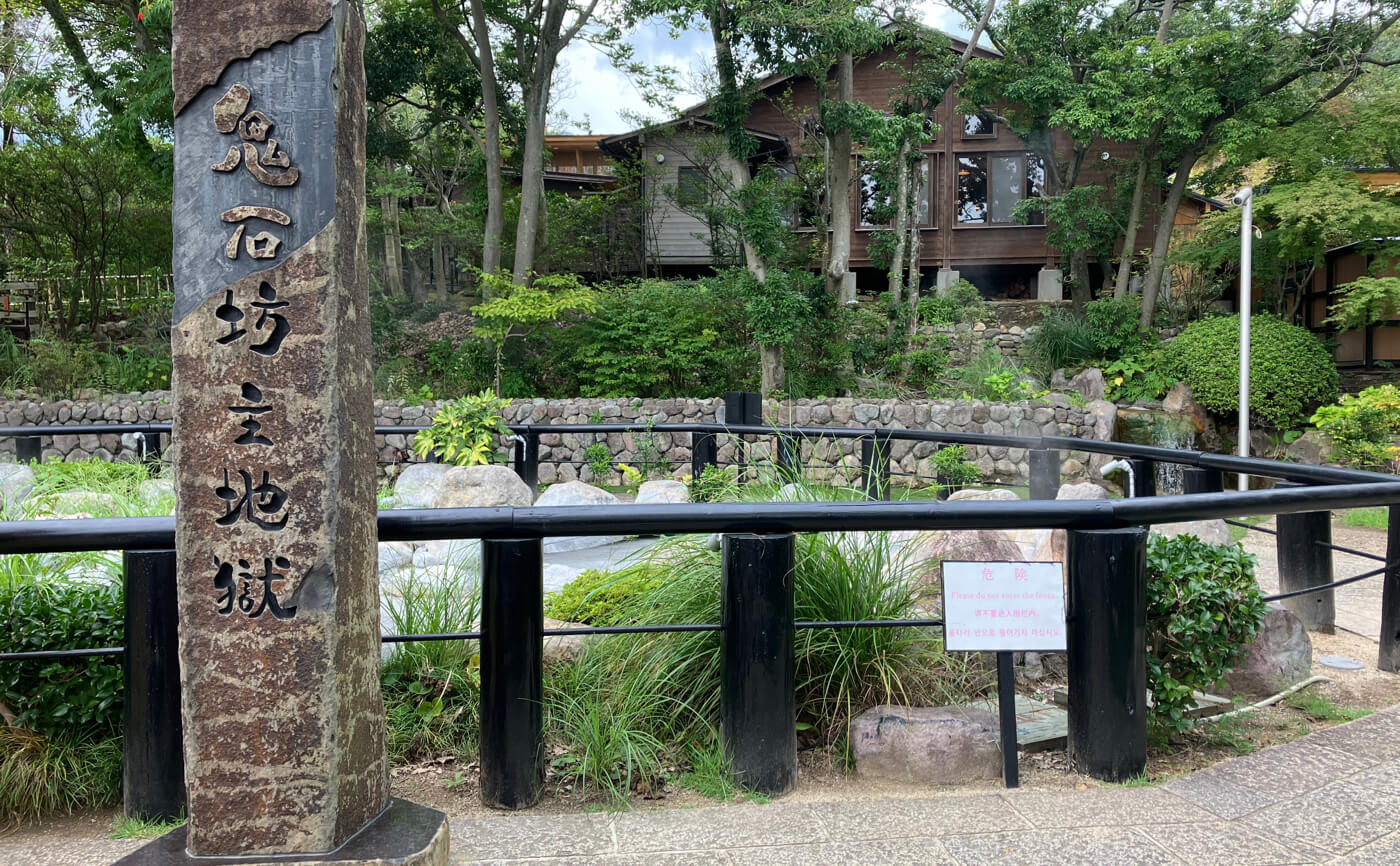
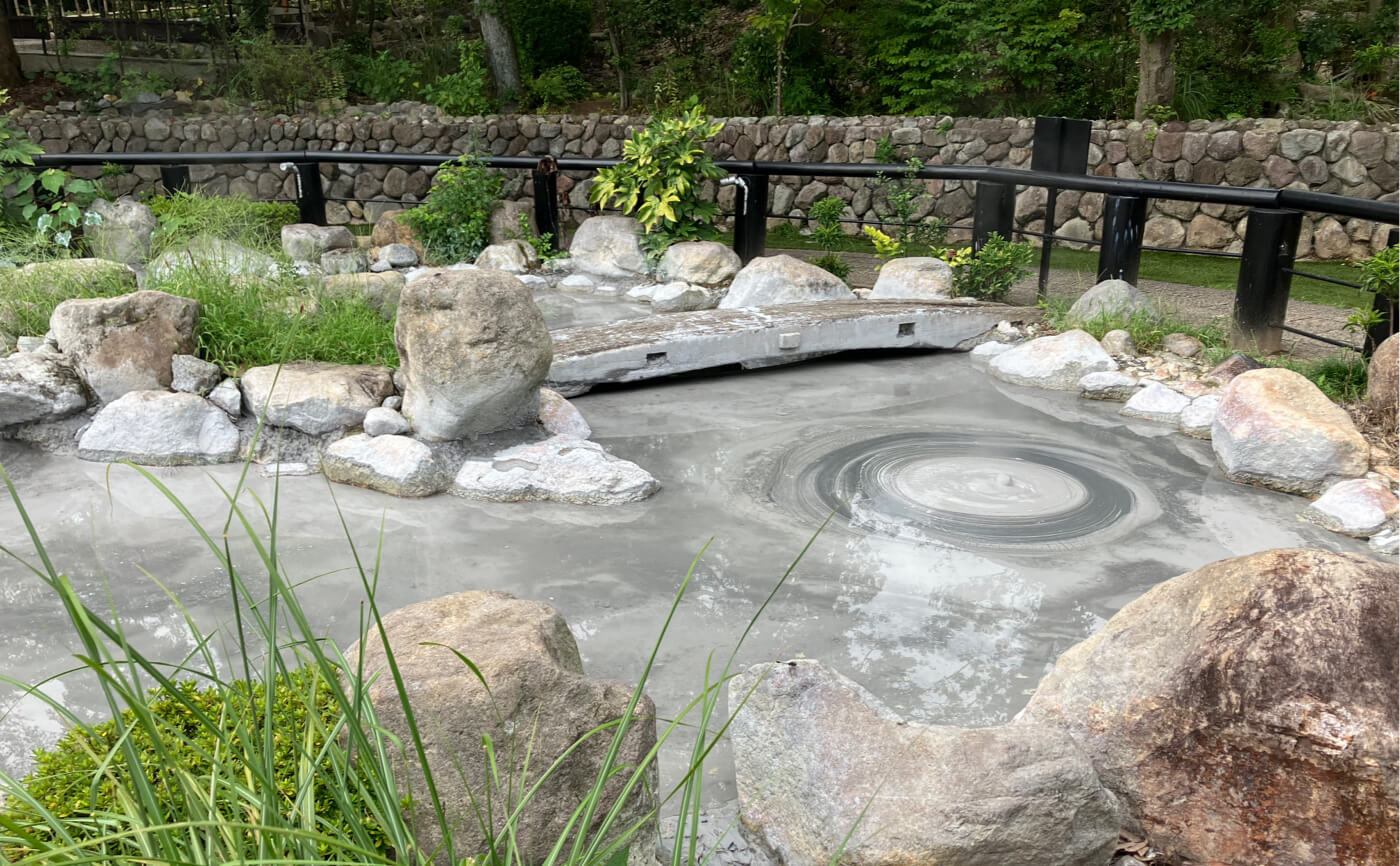
Mentioned in the Bungo Fudoki of 733 (Tenpyō 5), Oniishibozu Jigoku is a historic site where gray hot mud bubbles up in rounded domes resembling a monk’s shaven head—hence the name. Located next to Umi Jigoku, it’s convenient to visit both together. With spring temperatures around 99°C, the site offers a distinctive, otherworldly mud landscape.
Within the grounds you’ll find a relaxing foot bath and popular treats like “jigoku-steamed pudding.” Don’t miss the local specialty “Kanjidori Manjū,” buns steamed with geothermal heat and filled with Oita’s branded Kanjidori chicken, along with a variety of other steamed goodies.
Adjacent “Oniishi-no-Yu” (separate fee) is a full-fledged bathing facility offering cypress indoor baths, open-air baths (cypress or rock), and a scenic-view bath. Private family baths—wheelchair-accessible—are also available. Amenities such as shampoo, body wash, hair dryers, and free lockers are provided. Bring your own towel, or purchase one on-site for a hassle-free soak between sightseeing stops.
Oniyama Jigoku (Demon Mountain Hell)
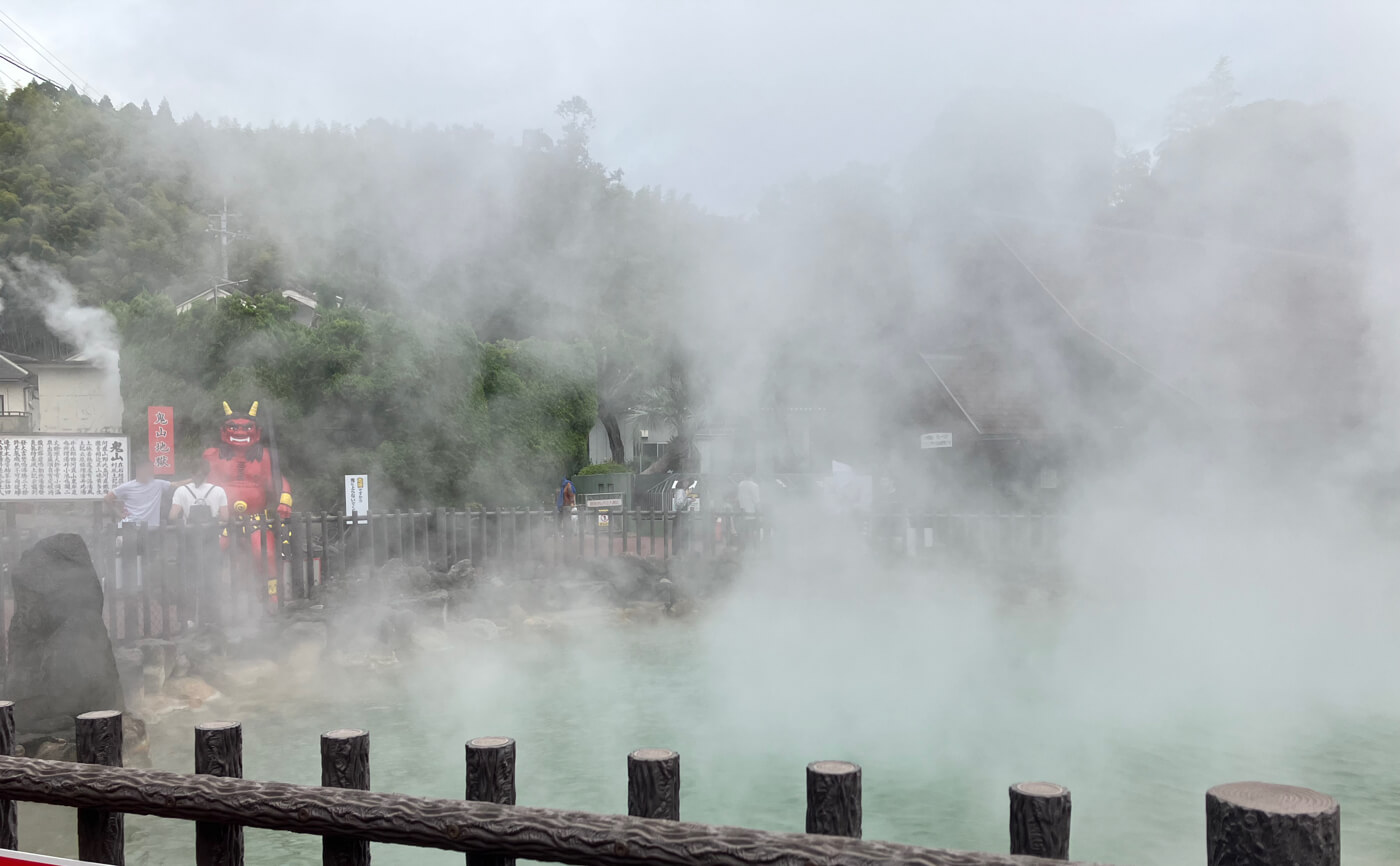
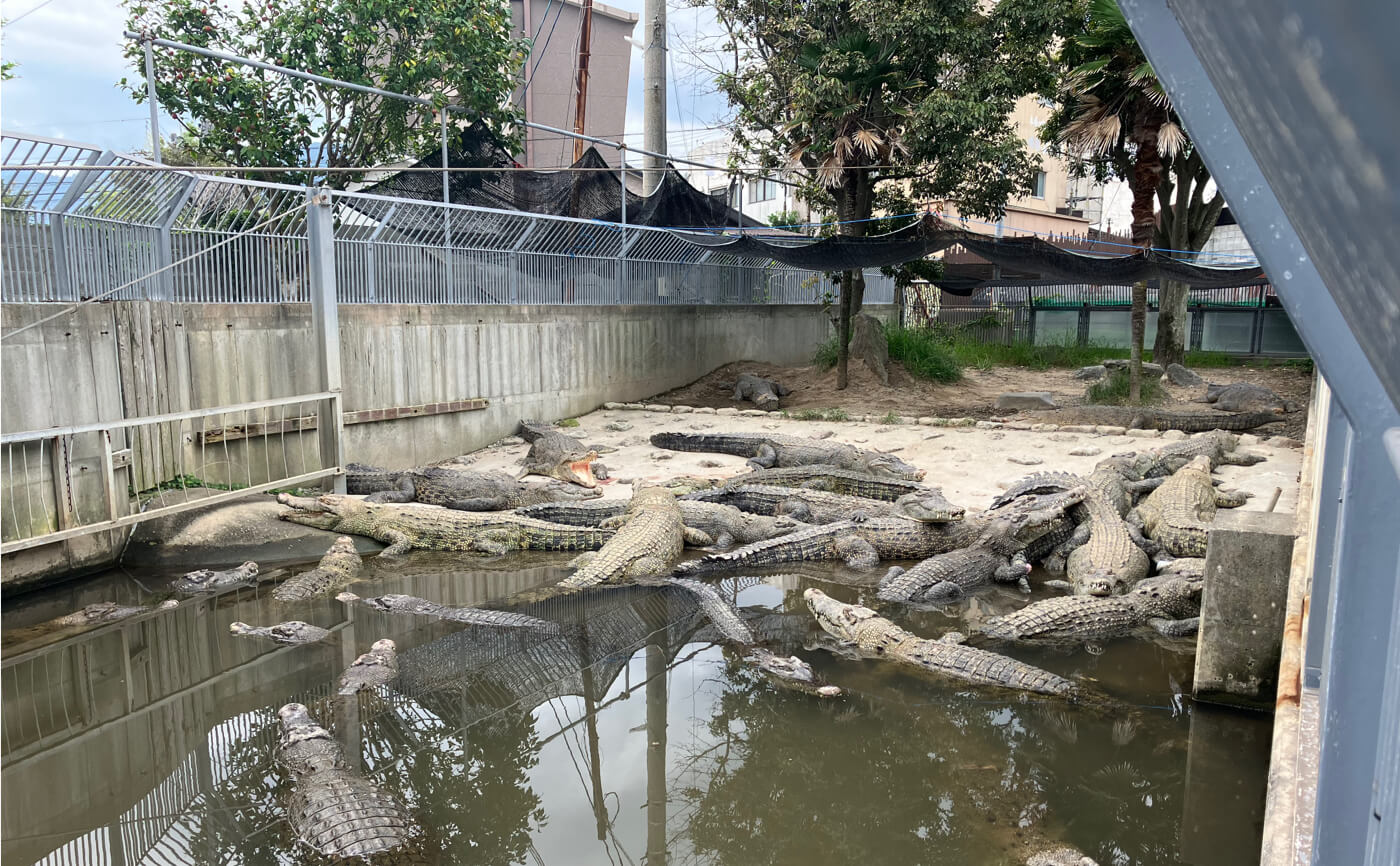
Oniyama Jigoku is also known as “Crocodile Hell” due to its unique feature. In 1923, it became the first place in Japan to use hot spring heat to raise crocodiles. Today, about 70 crocodiles and alligators live here, thriving in the warm environment created by the geothermal energy. The spring itself is a sodium chloride hot spring with a temperature of around 99°C, providing the conditions needed to keep these exotic reptiles comfortable.
At the entrance, visitors are welcomed by a red demon monument, and inside the exhibition hall, you can view displays such as the taxidermy of “Ichiro,” the first crocodile raised here. Alongside the thrilling sight of live crocodiles, these exhibits provide a sense of history, making Oniyama Jigoku a unique blend of zoo-like attraction within the Jigoku Meguri experience.
Kamado Jigoku (Cooking Pot Hell)
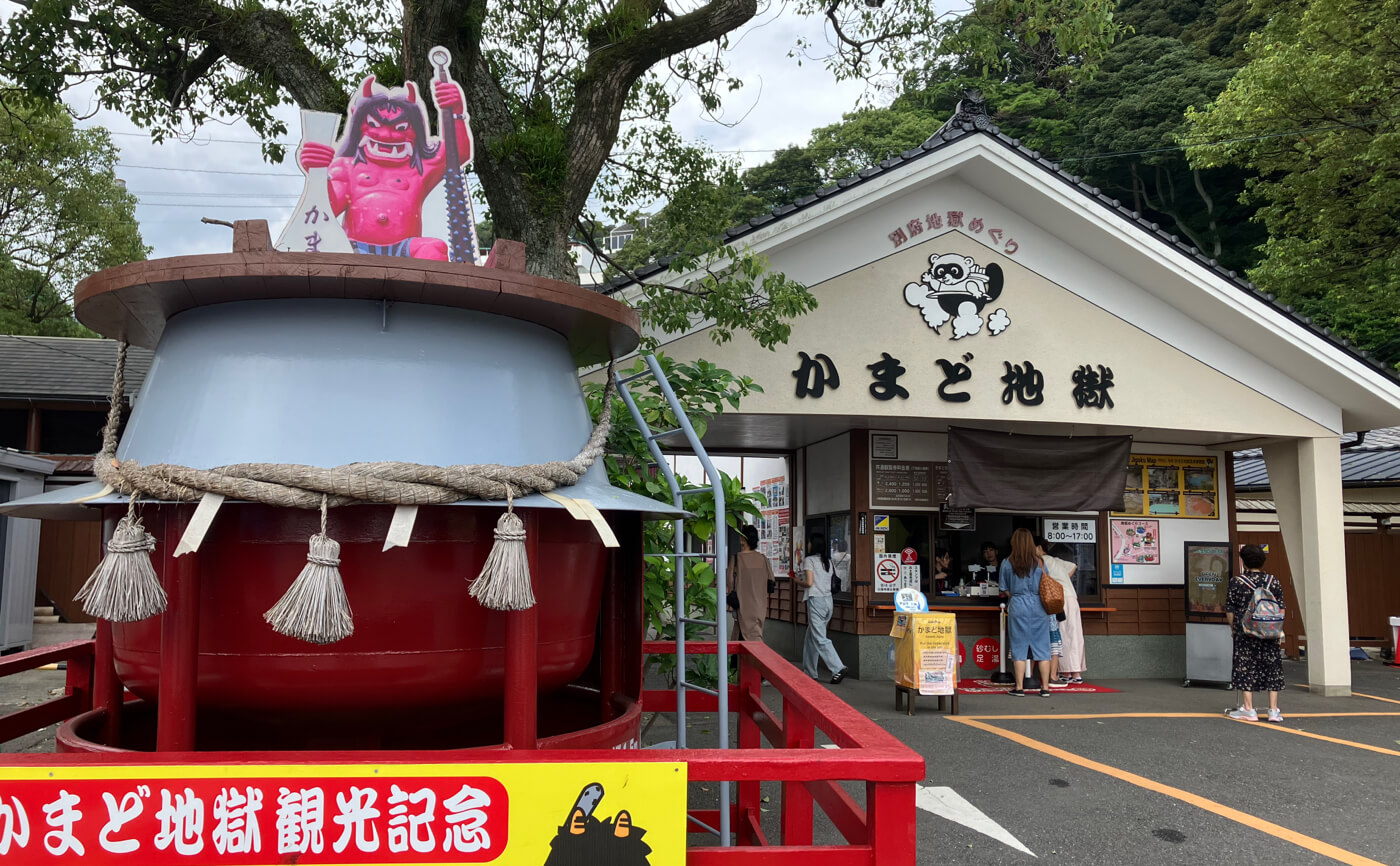
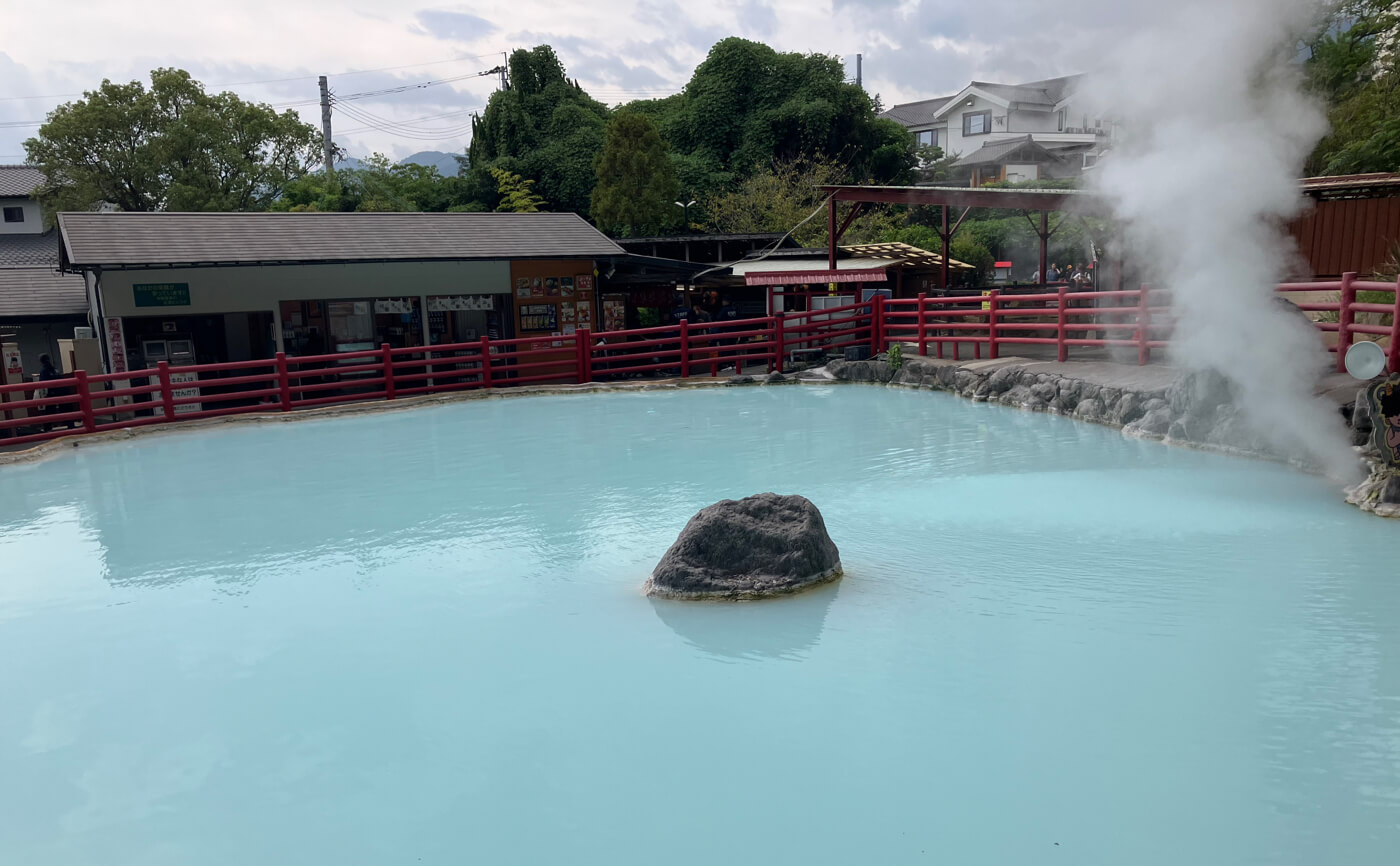
Kamado Jigoku takes its name from the local Kamado Shrine, where in ancient times the steam from this site was used to cook rice offerings during festivals. The grounds feature six different pools, each with its own color and characteristics, creating a dynamic landscape that changes from one section to another. The spring water is a sodium chloride hot spring, with temperatures reaching about 98°C.
The highlight of Kamado Jigoku is its interactive “experience corner.” Visitors can sample the hot spring water (around 80°C) in a drinking-on-sen experience, try “steam baths” for their hands and feet, or even voice-based experiences like the “throat steam,” said to have moisturizing and health benefits. These playful activities set it apart from other hells.
The on-site shop offers unique delicacies such as “onsen century eggs” steamed in geothermal heat, original sweets like soy sauce pudding, matcha pudding, and matcha manju, all exclusive to this location. Seasonal decorations create fun photo spots, and a free foot bath is available, making Kamado Jigoku a well-rounded spot for sightseeing, food, and relaxation.
Make the Most of Your Beppu Trip
Onsen Experiences to Pair with the Jigoku Meguri
Tour Local Communal Baths
Beppu’s appeal goes far beyond the Jigoku Meguri. The city is dotted with neighborhood communal baths used daily by locals, and travelers are welcome too. Admission is typically just ¥100–¥300, making it easy to experience an authentic, no-frills side of Japanese bathing culture and even chat with residents—quite different from luxury resort spas, and highly recommended for international visitors.
Try Sand Baths and Steam Baths
Two uniquely Beppu experiences are the sand bath and the steam bath. In a sand bath, you’re gently buried in naturally heated sand that warms the entire body and promotes circulation. The stone-chamber steam bath uses onsen steam like a natural sauna, long believed to offer wellness and beauty benefits. Both are rare worldwide and make for unforgettable travel memories.
Open-Air Baths Popular with International Visitors
Beppu also offers many open-air baths (rotenburo) with sweeping views. From hillside baths you can gaze out over Beppu Bay; at night, soak under the stars with city lights below. The Myōban and Kannawa areas, in particular, feature scenic outdoor baths that are favorites among overseas travelers. Immersing yourself in nature while bathing is one of the most soothing ways to experience Japan’s onsen culture.
Enjoy Beppu’s Local Cuisine
Jigoku-Mushi Cuisine
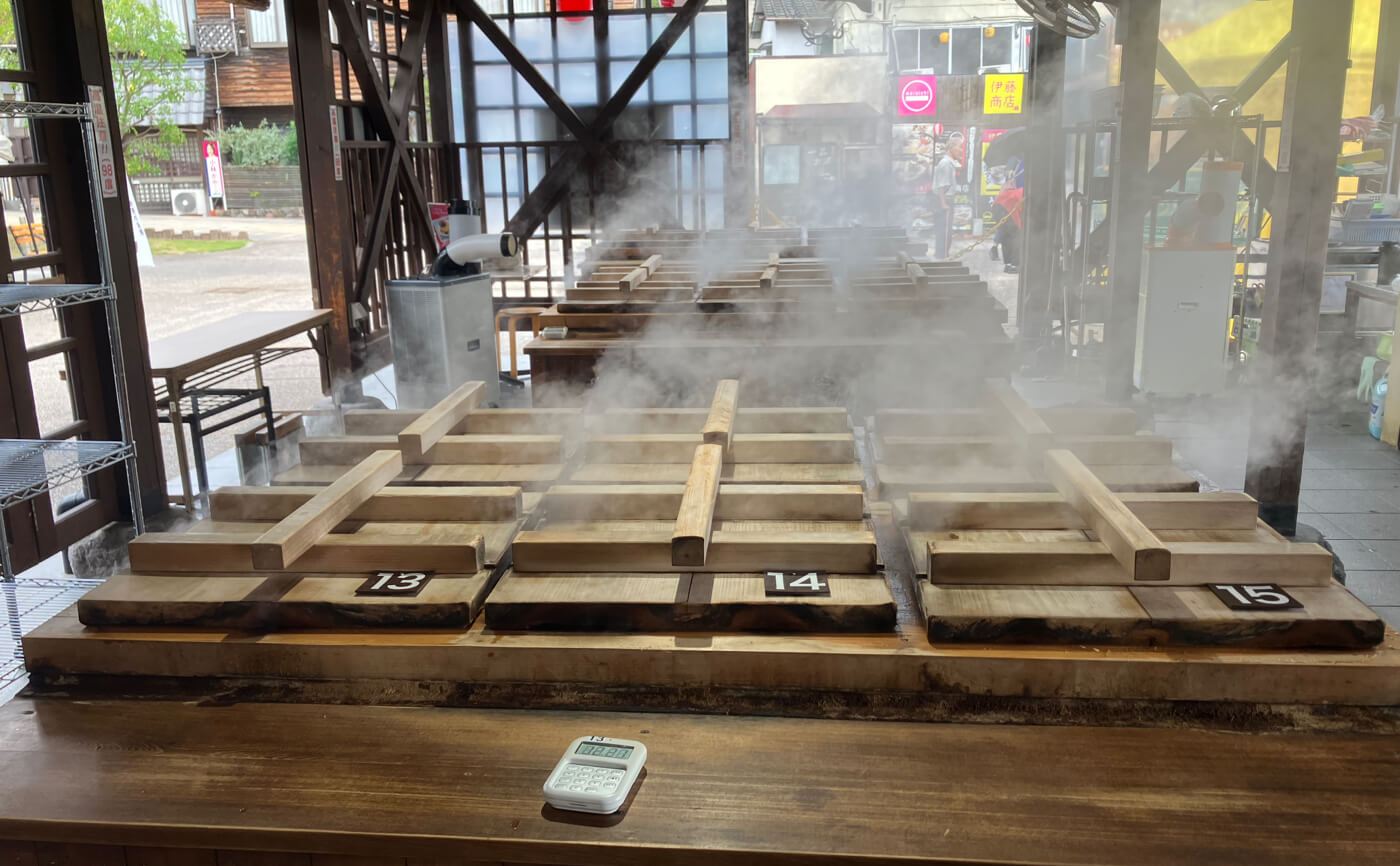
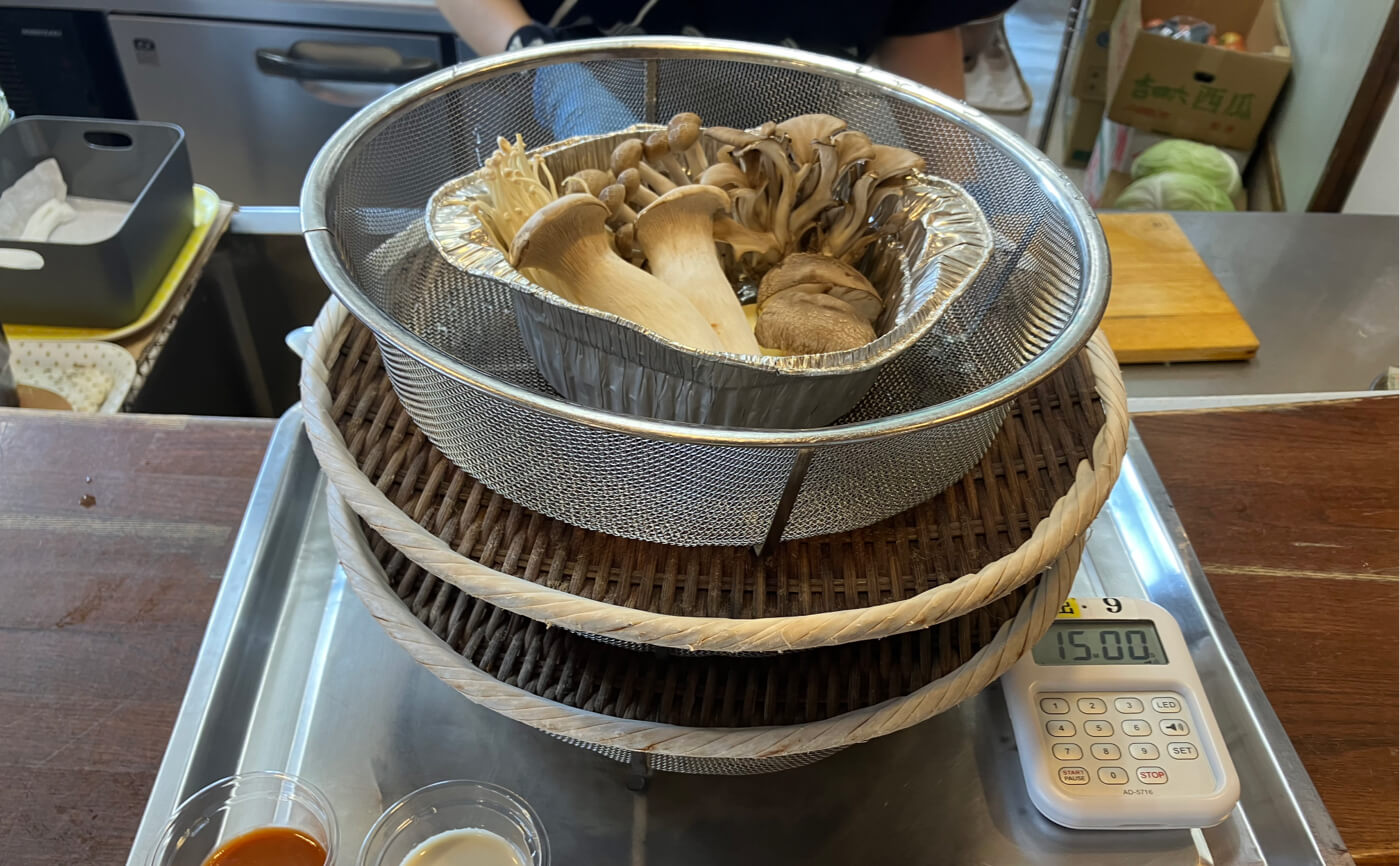
One of Beppu’s most iconic local dishes is jigoku-mushi, or “hell steaming.” This cooking method uses the nearly 100°C geothermal steam from the hot springs to steam ingredients such as seafood, vegetables, and eggs. The steam locks in the natural flavors without oil, making the dishes both healthy and delicious. Many of the Jigoku Meguri sites have experience corners where visitors can try steaming food themselves, adding a fun interactive element to the meal.
Toriten and Dango-Jiru
Two must-try specialties of Oita Prefecture are toriten and dango-jiru. Toriten is a local version of tempura-style fried chicken, known for its crispy coating and juicy meat, often served with a light dipping sauce. Dango-jiru is a comforting miso-based soup with flat wheat flour dumplings and seasonal vegetables. Both dishes offer simple yet hearty flavors and are a wonderful way for travelers to experience the taste of Japanese home-style cooking.
Local Sake and Craft Beer
Beppu and the greater Oita region are also rich in sake and craft beer culture. Locally brewed sake, often crisp and refreshing, pairs perfectly with jigoku-mushi dishes and toriten. Oita’s growing craft beer scene features unique products, some with playful “hell-themed” labels. Sipping a glass of local sake or beer after a day of hot spring adventures and local cuisine is the perfect way to complete the Beppu experience.
Immerse Yourself in Japan’s Hot Spring Culture in Beppu
Beppu is one of the world’s leading hot spring cities, famous for its abundance of spring types and water volume. It offers unique experiences such as the Jigoku Meguri and jigoku-mushi cuisine that can’t be found elsewhere. From the seasonal beauty of rising steam and the charm of humble communal baths to encounters with local food, Beppu leaves visitors with unforgettable memories. For those seeking the power, relaxation, and cultural richness of Japanese onsen, Beppu is truly an unmissable destination.
